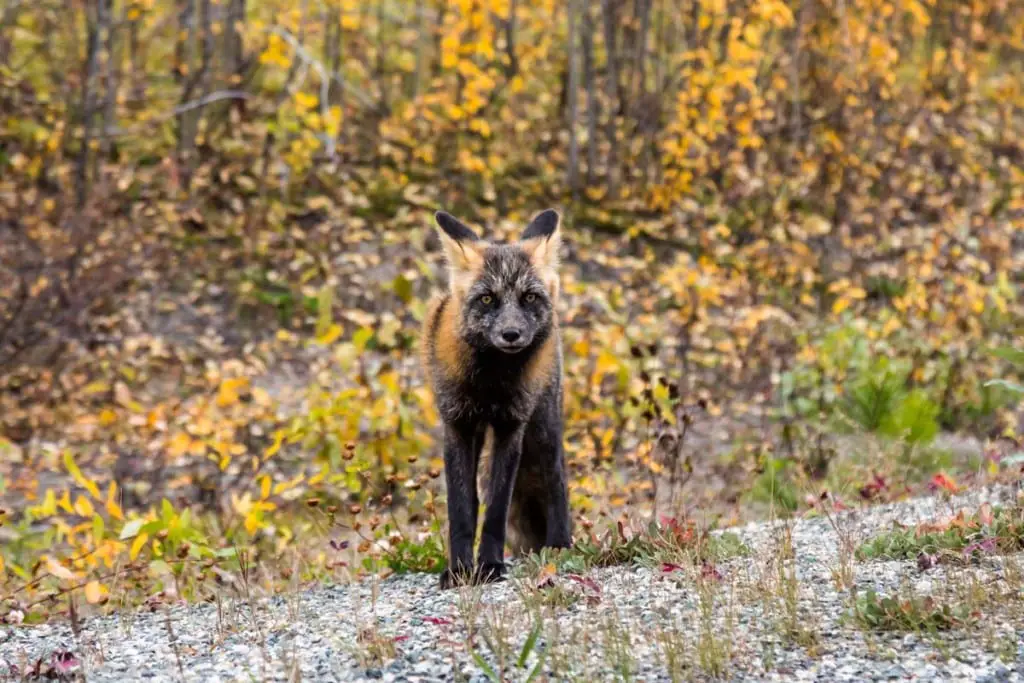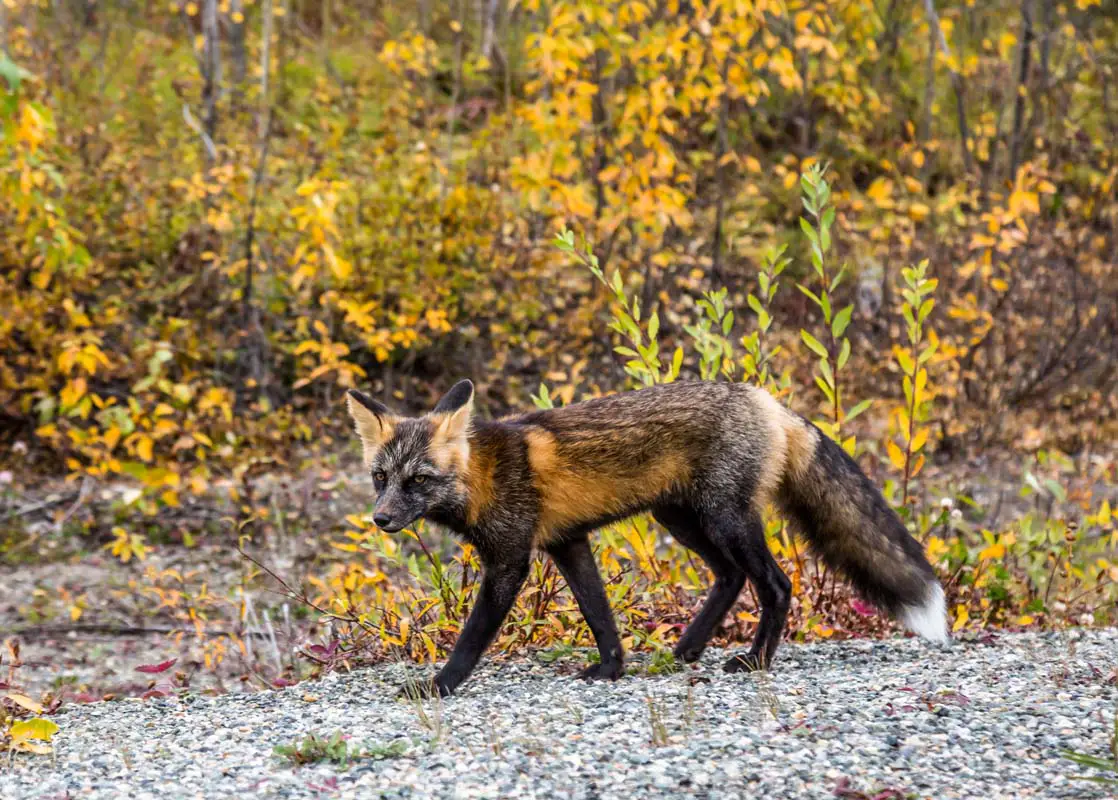There are many interesting types of foxes, different species, color mutations, and more. The cross fox is one of the coolest of them all!
Cross foxes are red foxes (Vulpes, Vulpes) that have a partially melanistic color morph. The melanin causes the red fox to have a strip of dark fur down its back and across its shoulders that cross.
Watch Cross Fox Video
Subscribe to our Youtube Channel for weekly videos!
The cross fox is a fox that stands out to most people. It’s beautiful and it’s unusual colors make us marvel at them.
We’ve put together this list of facts that you probably didn’t know about this mysterious creature.
At one point scientists thought that this fox was its own species, but it was later found that they were red foxes that had a mutation.

1. Cross Foxes Are Red Foxes With A Color Morph
The cross fox is one of the coolest looking foxes. What many people may not know is that they are actually a red fox with a partial melanin color variation or color morph.
Red foxes have more than one color morph, find out more about color morphs and mutations here.
A cross fox is created when a red fox morph mates with a silver fox morph, and sometimes two silver foxes can also produce these types of foxes.
They all fall under the red fox species, (Vulpes, Vulpes) however, the cross fox was once thought to be a different species of fox called (Canis decassatus.)
2. What Is Melanin?
Melanin is a color mutation that happens in the skin, that makes the skin and hair a dark color. Cross foxes have partial melanin, where some of the black/dark pigments meet the usual lighter colors.
Silver foxes also are melanistic and have more of the mutation than the cross fox does, making them almost completely black and some with very silver colors.
Albinoism is the opposite of melanin, where the skin and hair do not have any dark pigments.
Melanin is a mutation that exists in many animals and species, even in human beings.
3. Where Do Cross Foxes Live?
Cross foxes live mainly in North America, in the northern regions, such as Canda and northern America.
Many of these foxes live in Canada and around 30% of their red fox populations have this mutation.
There were cross foxes in the northern united states such as in Utah, but it is believed that the fur trade wiped them out of those areas for the most part.
They have also been seen in parts of Europe such as Scandinavia, and Finland.
4. Habitats and Behavior
Cross foxes have pretty much the same behaviors as the common red fox. Since cross foxes live primarily in the northern regions they are no strangers to snow and cold conditions.
They dig dens to have their kits and they sleep mostly outside in wooded areas. Their habitats consist of a den with multiple openings and sometimes even multiple dens spread out across its home range.
They are preyed on by large raptor birds, bears, and other animals that live in the northern territories.
Cross foxes that are urban are a little rarer, but there have been photographs of them crossing roads and venturing close to town.
5. Are Cross Foxes Rare?
Believe it or not, cross foxes are really not that rare. They make up for around 25% of all red fox variations in North America.
Their pelts were once more sought after by trappers and fur farms when it was thought that they were a different species than a red fox variation.
In Europe, there is a smaller amount of red foxes with the cross fox variation. In Finland, a study of 3,000 pelts found that only a tiny percentage of non-red variations foxes had the mutation.
6. Cross Fox Description
The cross fox has the shape of a red fox, although some have claimed that they are slightly bigger. They have a mixture of red and dark-colored fur, as well as some white fur.
They have a little bit more fur under their feet so that they can walk on snow and ice in the northern climates, similar to Arctic foxes.
There is more than one type of cross fox morph, which differs from the genetics of the parents.
The dark color goes down their back and to the tail, and across the shoulders. The red/orange color comes through in patches.

7. Cross Fox Tail
The tail on this fox is slightly more bushy than a common red fox variation. They are usually black with some orange or silver guard hairs showing through.
The tail can be a medley of black, orange, and white.
All cross foxes have white-tipped tails, just like red foxes, and silver foxes.
There can be some color variations with the tail as well as some unusual coloring.
A fox’s tail is used for communication. They signal other foxes with different signs, such as to be alert, or that they have buried food.
8. Cross Fox Morphs and Variations
The standard cross fox is a mix of black, orange, and white. However, there are some other variations of the color morph.
Color variations:
- Standard/common
- Gold cross
- Silver cross
The standard cross fox has a slightly lighter color variation than the other two morphs. With a lighter silver/black coat along with a lighter orange.
The gold variation is darker than the standard or common cross fox. The orange is a golden orange or even fire red. These are rarer than the standard.
The silver cross variation has a completely black body with orange around the ears and the cheeks. This is the rarest of these three.
All of these variations of white-tipped tails.
There are other cross fox color variations caused by recessive mutations.
9. Cross Fox Baby
Since there is a smaller percentage of these mutations, the babies are rarer than common red fox ones in the wild.
The common cross fox is created when a red fox mates with a silver fox.
It is believed that cross foxes have a similar gestation period as the red fox. Which is around 49 – 58 days.
They are usually born a light black color, or brown.
Their babies are just like any other red fox, they are fed by their parents until they can fend for themselves. They are taught to forage and to how to hunt after they venture out of the den.
Conclusion
The cross fox has been misunderstood for a very long time. It’s easy to see why they became victims of fur farms and trappers.
Their fur was once worn by holy men and priests and designated as an item of importance.
Cross foxes may not be as rare as some people think, however, they do possess a unique color morph that inspires the imagination.
It doesn’t take much for me to get excited about foxes but every time I see one of these beautiful foxes I can’t help but feel like nature has its very own paintbrush that makes everything on this planet unique.
The fox changes his fur but not his habits.
Anonymous
Frequently Asked Questions
Are there cross fox pets?
You can find a cross fox breed from a rescue or from a breeder that breeds them with other foxes. The pet fox trade has grown over the years and has many types of foxes.
Are there cross foxes in Russia?
Cross foxes are thought to be native to North America, however, some breeds of cross foxes could have made it into Russia through fur farms and the pet fox industry.
How long do cross foxes live?
Cross foxes may have a similar lifespan to a red fox, 3-6 years in the wild, and up to 14 years in captivity. Foxes in captivity live much longer lives.
Are cross foxes in America?
Cross foxes were native to northern parts of America at one point in history, however, they were almost completely eradicated. There could still be a small amount of them.

